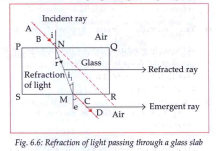When a ray of light passes through a parallel slab of transport medium, then show that angle of incidence is equal to angle of emergence.Solution in Punjabi
Step by step video & image solution for When a ray of light passes through a parallel slab of transport medium, then show that angle of incidence is equal to angle of emergence. by Physics experts to help you in doubts & scoring excellent marks in Class 12 exams.
Updated on:21/07/2023Topper's Solved these Questions
- REFRACTION OF LIGHTBOOK - MODERN PUBLICATIONCHAPTER - REFRACTION OF LIGHTEXERCISE - EXERCISE
168 Videos
- REFLECTION OF LIGHTBOOK - MODERN PUBLICATIONCHAPTER - REFLECTION OF LIGHTEXERCISE - EXERCISE
57 Videos
- SEMICONDUCTOR DEVICESBOOK - MODERN PUBLICATIONCHAPTER - SEMICONDUCTOR DEVICESEXERCISE - EXERCISE
174 Videos
Similar Questions
Explain the phenomenon of refraction at a plane surface separating two transparent media and show that μ=c/v where letters have their usual meanings.
View SolutionState the characteristis of image formed by a plane mirror.
View SolutionExplain the two processes involved in the formation of a p-n junciton diode. Hence defien the term"barrier potential".
View SolutionA ray of light is incident at an angle of 60∘ on the face of a prism having refracting angle 30∘. The ray emerging out of the prism makes an angle 30∘ with the incident ray. Show that the emergent ray is perpendicular to the face through which it emerges.
View SolutionA ray of light passes through the equilateral prism such that angle of incidence is equal to the angle of emergence if the angle of incidence is 45∘. The angle of deviation will be
View SolutionA ray of white light passes through a rectantular glass slab, entering and emerging at parallel faces. The angle of incidence, measured from the normal to the glaass surface, is large.
View Solutionजब प्रकाश को किरण सघन माध्यम से विरल माध्यम में जाती है तब अपवर्तन-कोण, आपतन-कोण से ……………… होता है
View SolutionWhen light passes through glass slab, the incident ray and emergent ray are ……………………. .
View SolutionShow that for refraction of light through a parallel glass slab, the incident ray and the emergent ray are parallel to each other. Or, With the help of a diagram show how in case of a rectangular glass slab, when light is refracted by the two parallel faces of the slab, deviation between angle of incidence and angle of refractive is zero.
View SolutionA ray of light passes through an isosceles triangle such that the angle of incidence is equal to the angle of emergence. If the angle of emergence and angle of incidence are both 45∘ then angle of deviation will be
View SolutionA ray of light passes through an equilateral prism such that the angle of incidence is equal to the angle of emergence and latter is equal to (3/4)th the angle of prism. The angle of deviation is
View SolutionA ray of white light passes through a rectangular glass slab, entering and emerging at parallel faces. The angle of incidence measured from the normal to the glass surface, is large. Then
View SolutionFor refraction of light through a glass slab the angle of emergence is equal to the angle of incidence.
View SolutionWhen a ray of light passes through a parallel slab of transport medium, then show that angle of incidence is equal to angle of emergence.
View SolutionRefraction of light passing through a glass slab. what is the relation between angle of incidence and angle of emergent? and which rays are parallel ?

View SolutionA ray of light passes through a plane glass slab of thickness t and refractive index n=1.5. The angle between the incident ray and emergent ray will be
View Solution
